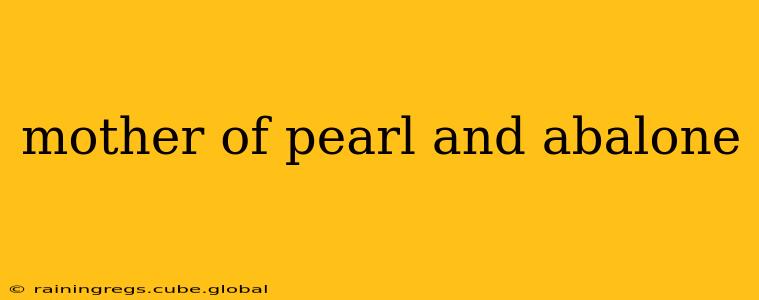Mother of pearl and abalone are both captivating materials renowned for their mesmerizing iridescence and lustrous sheen. Often confused for one another, they share a common origin – they are both nacre, the inner layer of certain mollusks' shells – but possess distinct characteristics that set them apart. This article delves into the nuances of mother of pearl and abalone, exploring their differences in appearance, formation, uses, and value.
What is Mother of Pearl?
Mother of pearl, also known as nacre, is the iridescent inner layer found in many shelled mollusks, including oysters, mussels, and freshwater clams. Its shimmering, opalescent quality stems from the layered structure of aragonite crystals and organic conchiolin. These layers diffract light, creating the characteristic play of colors. The color palette varies greatly depending on the species of mollusk and environmental factors, ranging from creamy white and pale pink to deep blues and greens.
How is Mother of Pearl Formed?
The formation of mother of pearl is a remarkable biological process. Mollusks secrete layers of calcium carbonate (aragonite) and conchiolin, a protein, to repair damage to their shells or create a smooth, protective inner lining. The meticulous layering, with each layer slightly offset from the last, leads to the diffraction of light and the creation of the beautiful iridescence.
What is Abalone?
Abalone refers to both the marine gastropod mollusk itself and its strikingly beautiful iridescent shell. The shell's inner layer is composed of nacre, similar to mother of pearl, but the structure and resulting visual effect differ significantly. Abalone shells typically exhibit a more intense, vibrant iridescence with bolder, more defined color patterns, often featuring rich greens, blues, pinks, and reds.
How is Abalone Formed?
The formation of abalone shell is analogous to mother of pearl, involving the layering of aragonite and conchiolin. However, the abalone's unique shell structure, with its larger, more regularly arranged crystals, leads to its distinctively vibrant and often more intense iridescence.
What are the Key Differences Between Mother of Pearl and Abalone?
While both are forms of nacre, several key differences distinguish mother of pearl and abalone:
- Color and Iridescence: Abalone displays a more intense, vibrant, and often bolder iridescence than mother of pearl. Mother of pearl tends to have a softer, more subtle shimmer.
- Pattern: Abalone often exhibits distinctive, swirling patterns, while mother of pearl's pattern is typically more subdued and less defined.
- Thickness: Abalone shell is generally thicker than mother of pearl.
- Species: Mother of pearl is sourced from a wider variety of mollusk species than abalone, which is specific to abalone mollusks.
- Cost: Due to factors like rarity and demand, abalone is typically more expensive than mother of pearl.
What are Mother of Pearl and Abalone Used For?
Both mother of pearl and abalone are highly prized materials with diverse applications:
- Jewelry: Both are frequently used in jewelry making, creating stunning earrings, necklaces, bracelets, and pendants.
- Inlays: They are used for decorative inlays in furniture, musical instruments (especially guitars), and other luxury goods.
- Buttons: Historically, mother of pearl buttons were incredibly popular, and some are still produced today.
- Decorative Items: Both are used to create decorative objects like boxes, bowls, and other artisan crafts.
Is Abalone More Valuable Than Mother of Pearl?
Generally, yes, abalone is considered more valuable than mother of pearl. Its rarer occurrence, more intense iridescence, and often larger size contribute to its higher price point. However, the value of both materials can also depend on the specific species, quality, and the intricacy of the crafting involved.
Where Can I Find Mother of Pearl and Abalone?
Mother of pearl is sourced globally from various regions where oysters and other pearl-producing mollusks are found. Abalone, on the other hand, is found primarily in coastal regions of the Pacific Ocean, including Australia, California, and Japan. Overfishing and habitat destruction have impacted abalone populations, highlighting the importance of sustainable sourcing.
This comparison provides a comprehensive understanding of the differences between mother of pearl and abalone, showcasing their unique characteristics and diverse applications. Both are remarkable materials showcasing the beauty of nature's artistry.
